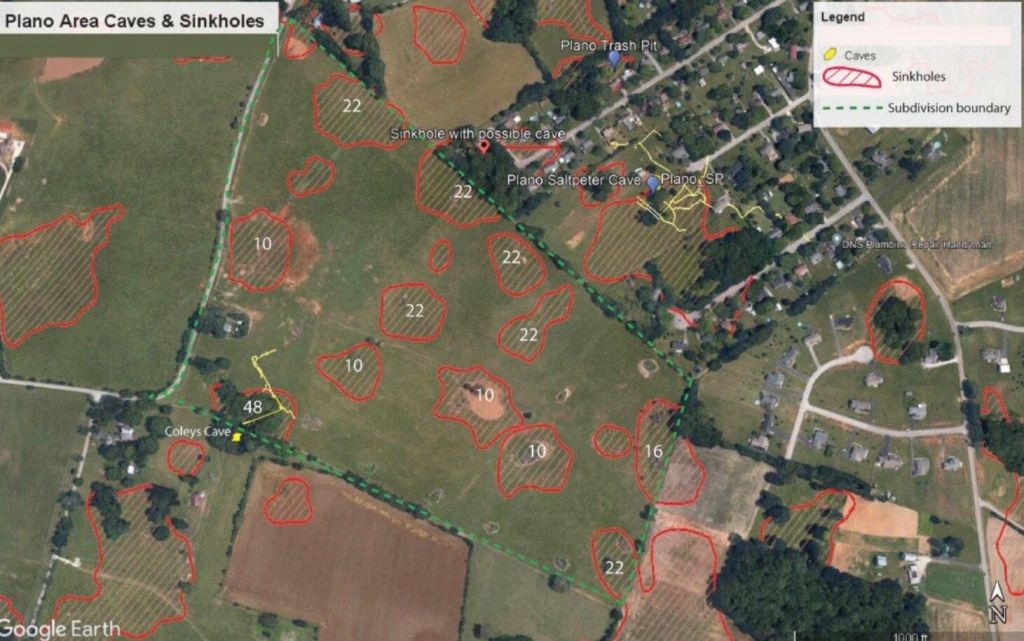Contested Plano rezoning approved at hearing
Published 8:00 am Friday, August 11, 2023

- A map showing caves and sinkholes located on 71.4 acres of property owned by JAB Holdings, Inc. off of Plano-Rich Pond Road that developers intend to convert into 65 single-family housing units. The map comes from a study of the area conducted by Dr. Patricia Kambesis of Western Kentucky University.
Major changes are coming to a patch of rural property south of Bowling Green, despite a wave of opposition from nearby residents.
Numerous sinkholes, a plethora of Native American artifacts, traffic concerns and the possible occupancy of an endangered critter were just some of reasons given by neighbors Thursday morning as to why they were against a developer’s plans to convert 71.4 acres of land off of Plano-Rich Pond Road into 65 single-family housing units.
The objections were voiced in a hearing in front of Warren County Fiscal Court, after which the magistrates voted 6-0 to officially rezone the patch of pasture from agriculture to residential estate to accommodate builder Jody Allen and JAB Holdings’ vision to install more housing to sate projected county growth.
Bob Davenport, a longtime resident of the area living just south of the proposed development, filed a notice of opposition to fiscal court on July 24 to request a “de novo” hearing on the issue, which would allow new testimony and information about the land to be heard.
The magistrates chose to schedule a hearing on record, in which they could only consider the information previously produced at the June 15 City-County Planning Commission meeting where the rezoning was first given a thumbs-up in the form of a 5-0 vote.
Allen’s company purchased the acreage from Charles Deweese Construction back in March as part of that company’s Chapter 11 bankruptcy reorganization. The final price tag clocked in at a hair over $1.1 million.
Davenport told the magistrates that he and his fellow residents are not opposed to subdivisions. He said that he attended the land’s auction in March, and that local farmers would not bid on the land.
“They knew of the inherent problems and wouldn’t touch it with a 10-foot pole,” he said.
Davenport stated that he and the developers saw different things when looking at the property.
“They saw 70 acres of rolling hills with a large pond in the middle, a white farm fence and a subdivision with 65 half-million dollar homes,” he said. “I saw 70 acres with many sinkholes, a cave system protected by the Kentucky cave protection statute, a landfill dump full of construction debris and Native American hunting grounds.”
Philip Carter, a retired engineer and land surveyor, told the magistrates he was concerned about the increased traffic the development would bring to Plano-Rich Pond Road.
“The section of road adjacent to this property is very dangerous due to the existing sight distance issues,” Carter said. “There are three hillcrests and one horizontal curve with limited sight distance on just this section of road, which combined with the narrow pavement are responsible for numerous serious accidents in the past.”
Judy Schwank, a local attorney who owns over 13 acres of land adjoining the property, provided the Daily News with a copy of her own notice of opposition that included a notarized sworn affidavit.
In it, Schwank states that in her youth she explored a cave that has its entrance partly on the N.O. Coley Farm, which is now part of the rezoned property. She states that she found numerous Native American artifacts inside what she called the “Coley Cave.”
The affidavit also states that Dr. Patricia Kambesis, a professor from Western Kentucky University with interests in caves and karst terrain, has performed a detailed geological study of the area that raises “significant concerns” for the development.
Schwank provided a copy of that study to the Daily News, which states that the site is home to 15 sinkholes of varying depths and that there are 11 known caves within 1.5 miles of the property, including Coley Cave located directly under JAB Holdings’ land.
According to the study, which drew upon data from the Kentucky Geological and Speleological surveys as well as direct field observations, Coley Cave varies in depth below the surface between 15-25 feet at its shallowest and 45 at its deepest.
It goes on to state that half of the proposed housing unit sites sit atop sinkholes, and that locals reported a major sinkhole collapse just north of the property 10 years ago in the Plano Baptist Church Cemetery.
Additionally, Schwank told the Daily News that Kambesis contacted her mere days before the hearing to confirm that a cave-dwelling flatworm she had found in Coley Cave had been identified as Sphalloplana Buchanani.
According to the non-profit NatureServe, that creature is “critically imperiled.”
During the hearing Schwank told the magistrates that the neighbors had “emergency” information to share, but she was not able to speak regarding the cave discovery as it had not been mentioned at the June 15 planning commission meeting.
Schwank told the Daily News she had filed a notice to the Environmental Protection Agency about the cave dweller.
The Daily News made multiple attempts to contact Kambesis about the study and flatworm specimen but could not reach her. Schwank said she had left for a cave mapping trip to Mexico shortly before the hearing.
Dr. Ingrid Cartwright, an associate professor of art history at Western Kentucky University living near the property, stated that the planning commission’s zoning decision was based on incorrect geophysical data, and that the developer’s application does not mention the cave complex lying beneath.
She added that she’s found and documented thousands of artifacts on her property that she believes are consistent with tools and technology used by Native Americans in the Archaic period.
“I am working with the Kentucky Archaeological Survey to pass the baton to professional archaeologists,” Cartwright said.
Cartwright told the magistrates that rezoning would be in violation of the Kentucky Antiquities Act, which makes the preservation of archaeological sites and objects of antiquity public policy, as well as the Kentucky Cave Protection Act.
Attorney Chris Davenport, representing JAB Holdings, reiterated to the magistrates that the planning commission’s decision in June was a united one. He also stated that the proposed land use is in accordance with the planning commission’s future land use map.
He said that the 71.4 acres of land does not exist in a vacuum.
“Most of this opposition lives in subdivisions in the area. Their homes are presumably really no different from these homes,” he said. “Their homes sit on septic systems that were approved and are operable. Their homes sit on the same karst geography that this 71 acres does.”
As to traffic concerns, he said the development will be served by a better traffic system than the one that currently exists since one of the conditions contained in the developer’s application was to widen the roadway to a minimum of 18 feet.
Another condition is that all sinkholes on the property will be dealt with in a manner approved by the county’s public works department.
“I dare say if you pick up a map and threw a dart at it, you’re going to get pretty close to a sinkhole – current, future or past in Warren County,” he said.
The attorney made reference to a statement Bob Davenport gave at the planning commission meeting, in which he said that the board should be making its decision based on things like common sense, safety and the environment rather than “checking boxes for compliance with existing codes, regulations and ordinances.”
He stated that those words were an invitation “not to do the job that’s really before you, but to decide the issue on some other matter.”
“I would submit to you that if you do that … What’s the point of this process?”
Bob Davenport had no further comment following the vote, except that he was disappointed in the outcome and that the neighbors’ next stop will be in circuit court.






